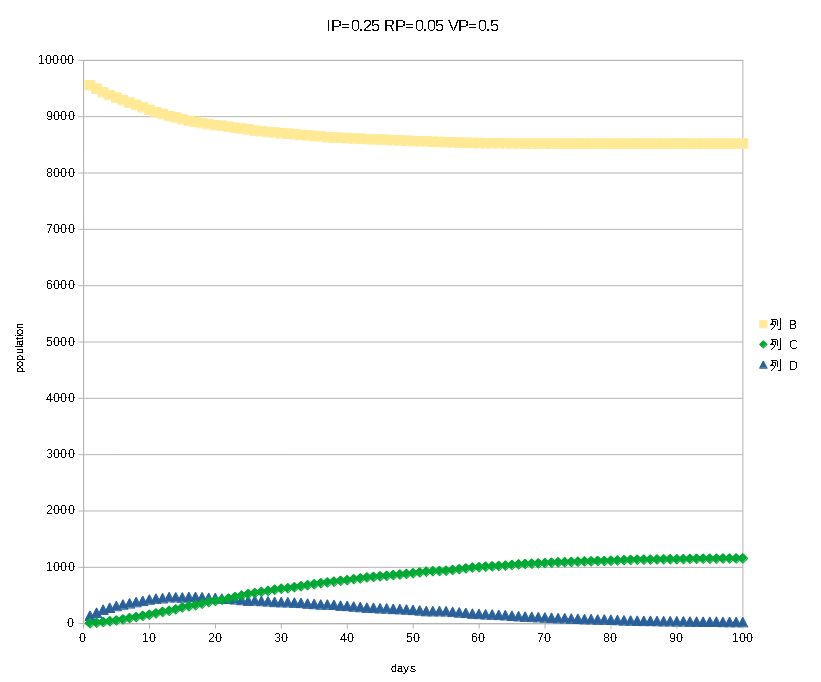
Stay Home (Nesting) project part 2: Improvement of the infection simulation prototype. I wrote an article about it in May on FaceBook. For your reference 14th July 2020
なお今回のSimが以前にご紹介した「碁石モデル」の改良版との違いは,碁石モデルでは,感染(地震における破壊)するかどうかのサイコロを振るときに,
感染しない場合は即,免疫が生じたとしていたのですが,今回は感染しない場合は放置です.また免疫は感染した格子のみが,ある一定時間経って確率RPで回
復し免疫を生じるという風に変えています.
さらに感染確率IPの意味は単位時間(ここでは1日と考えてもよい)で何人に感染させるかという確率です.IPが0.25ということは,4人の人に隣合う
とき,うち1人を平均して感染させるという意味です.また感染は格子が隣あうときにのみ生じて,それ以外の遠い人には及びません.これをコンタクトプロセ
スと呼ぶようです.またRPは快復して免疫を生じる確率ですが,例えばこれが0.05ということは,一度感染した人は平均20日程度で快復して免疫を生じ
るということです.今回の空隙パラメータを追加したプログラムはこれです.(4/17追記.グラフの人数は空隙率を無視していることに気付きました.実際
には格子全体から空隙を引いたものが全体の人数になります)
http://yossi-okamoto.net/programs/COVID_19_ST.pde
I improved yesterday's infection sim a little and calculated what happens if there are gaps among human grids. The effect of avoiding closeness becomes clear. A new parameter VP indicates the percentage of occupying gaps: VP of 0.25 means that there are 25% of gaps in the whole lattice.
The difference between 1) this simulation and 2) the improved version of the "Goishi Model(Go-Game Model, Ohtsuka,1971)" introduced previously is the treatment of immune. In the case of 1) the original Goishi Model, when the dice decides the lattice is infected (destroyed in an earthquake), nothing happens. However if it is not infected, the lattice is considered immune immediately (means the site is rigid, so no destruction happens after that). In the new model, however, 2) the case of no infection site is left alone, and only the infected lattice is immune to infection after a certain period of time, with a probability of recovery (RP).
The probability of infection IP is the probability of infecting a given number of people in a unit of time (in this case, one day). 0.25 IP means that when 4 people are next to each other, one of them will be infected on average. In addition, infection occurs only when the lattices are adjacent to each other, and not to other distant persons. This is called "contact process". The RP is the probability of recovery and immunity. 0.05, for example, means that once infected, a person will recover and become immune in about 20 days on average. This is the program to which the void parameter was added. (Added on 4/17. I noticed that the number of people in the graph ignores the porosity. In reality, the total number of people is the total lattice minus the voids.)
http://yossi-okamoto.net/programs/COVID_19_ST.pde


